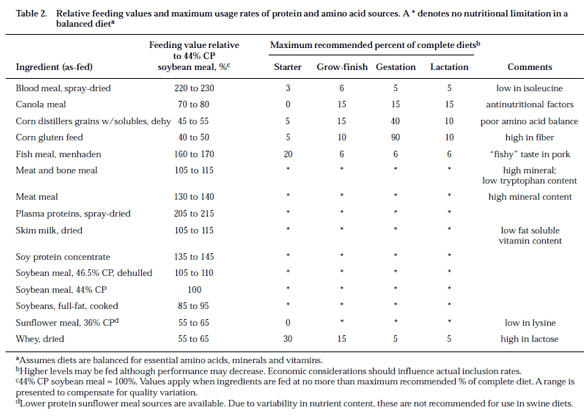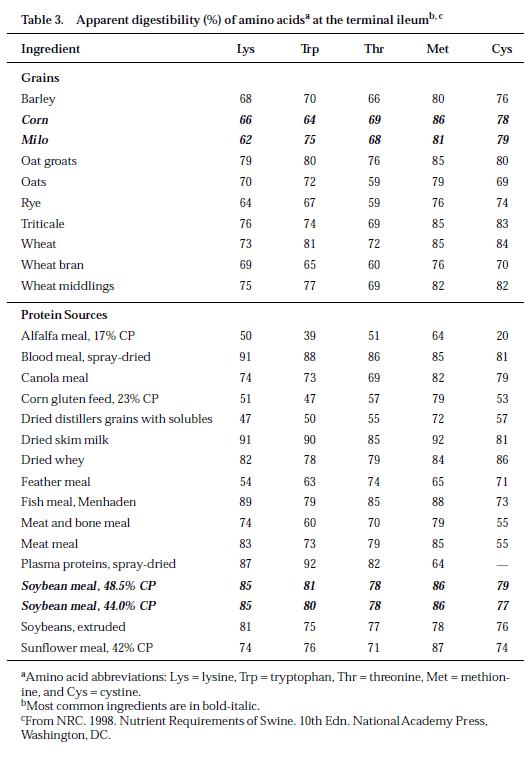Swine Nutrition Guide: Nutrient Sources - Protein and Amino Acids
Protein and Amino Acids -- Pigs of all ages and stages of the life cycle require amino acids to enable them to grow and reproduce. Amino acids are the structural units of protein. During digestion, proteins are broken down into amino acids and peptides.
The amino acids and peptides are absorbed into the body and are used to build new proteins, such as muscle. Thus, pigs require amino acids, not protein. Diets that are “balanced” with respect to amino acids contain a desirable level and ratio of the 10 essential amino acids required by pigs for maintenance, growth, reproduction and lactation. Those 10 essential amino acids for swine are arginine, histidine, isoleucine, leucine, lysine, methionine, phenylalanine, threonine, tryptophan and valine.
The proteins of corn and other cereal grains are deficient in certain essential amino acids. Protein supplements are used to correct the amino acid deficiencies in grains. For example, the correct combination of grain and soybean meal provides a good balance of amino acids.
Soybean meal is often the most economical source of amino acids for pigs in Nebraska and South Dakota. However, economic conditions can change, making alternative amino acid sources attractive for use in pig feed.
How does one determine whether another source of amino acids is more economical?
Use the relative feeding value of amino acid sources shown in Table 2 when considering alternative amino acid sources. These feeding values were calculated using the ME, digestible lysine and available phosphorus content of feedstuffs. Corn, soybean meal (44% CP) and dicalcium phosphate were used as reference feedstuffs.
Soybean meal (44% CP) is assumed to have a feeding value of 100%. Good quality meat and bone meal, for example, has a feeding value of 110% of that of soybean meal. Thus, meat and bone meal can replace soybean meal in the diet when the price of meat and bone meal is less than about 110% of the price of the same weight of soybean meal.
For example, if the meat and bone meal price is less than about $220/ton, it is a better buy than 44% CP soybean meal that costs $200/ton ($200/ton x 1.10 = $220/ton). The relative feeding values apply when ingredients are included in diets in quantities no greater than those shown in Table 2.
Average daily gain and reproductive performance will not normally be reduced by replacing soybean meal with any of the amino acid sources at the levels shown in Table 2.
A range in feeding value is presented to account for variation in ingredient quality and individual producer goals.
Most amino acid sources are byproducts and subject to some variation in quality, because of the processing methods used. Also, be sure to consider factors such as storage costs, handling characteristics and availability.
Are there differences in uniformity of product among protein sources?
Animal protein products vary in composition and quality more than plant protein sources. Meat and bone meal and meat meal are byproducts of the meat packing industry, and their composition depends on the animals slaughtered. Methods of processing also influence the quality of animal proteins.
The rendering process (270 to 280oF) is sufficient to kill salmonella and other bacteria present in the raw material, but through improper handling, the rendered product can be recontaminanted. Buying animal proteins from a reliable supplier will reduce the impact of this quality variation on pig performance.
Many plant proteins are more uniform because they are made from a single source. Also, methods of processing plant proteins have become standardized, and the same kind of product can be produced year round. However, improper processing can occur in the production of soybean meal and other plant proteins.
Also, calcium carbonate (limestone) can be added to plant protein products (up to .5%) to prevent them from becoming lumpy and to maintain good flow characteristics. The additional calcium is no problem as long as one knows how much is in the protein source.
Salmonella contamination traditionally has been associated with animal protein products. However, recent evidence indicates that grains and plant protein products can also be contaminated with salmonella.

What is meant by digestible amino acids?
Only a certain proportion of each of the amino acids in a feedstuff is digested and absorbed by pigs. Digestibility values for major amino acids in many feedstuffs are shown in Table 3. To calculate the digestible amino acid content of a feedstuff, multiply the total quantity of the amino acid in the feedstuff by its digestibility value in Table 3.
For example, the digestible lysine content of 44% CP soybean meal containing 2.83% lysine is 2.41% (2.83 x .85). Differences in digestibility can be ignored when formulating diets that consist primarily of corn or milo and soybean meal (with no byproduct ingredients). Thus, these diets can be formulated on a total amino acid basis.
When nontraditional or byproduct ingredients are used in feed, it is best to formulate the diet on a digestible amino acid basis. Otherwise, pigs may not perform as expected. Digestible lysine recommendations are given in Tables 11, 12, 13, 14, and 15.

What is meant by ideal protein or amino acid balance?
The concept of an ideal protein or ideal amino acid balance is to provide a perfect pattern of essential and nonessential amino acids in the diet without any excesses or deficiencies. This pattern is supposed to reflect the exact amino acid requirements of the pig for maintenance and growth.
Therefore, an ideal protein provides exactly 100% of the recommended level of each amino acid. Although standard diets are usually formulated to meet the pig’s requirement for lysine (the most limiting amino acid), excesses of many other amino acids exist. Two practical methods can provide a more ideal balance of amino acids in pig feed: Use a combination of supplemental protein sources or formulate the diet with crystalline amino acids.
Questions often are asked about whether the excess amino acids hurt pig performance and whether reduction or elimination of the excesses would improve pig performance. There is little evidence to indicate that the performance of pigs fed diets containing a more ideal balance of amino acids is better or worse than that of pigs fed practical corn-or milo-soybean meal-based diets. However, if excess amino acids are reduced, nitrogen excreted through the urine and feces will be reduced, meaning that less nitrogen is in the manure.
This will reduce the amount of land required to properly manage the nitrogen in the manure. Unless there is a strong incentive to reduce nitrogen in the manure, choose sources of amino acids that will produce the lowest cost gain.
How should alternate amino acid sources be included in the diet?
Check Table 2 to see if there is a suggested limitation on the quantity of the ingredient to include in the diet. Then reformulate the diet on a total or digestible lysine basis and check that the tryptophan, threonine and methionine levels are adequate. Formulating on a digestible lysine basis is the most precise. Do not formulate diets on a protein basis because the diet could be deficient in lysine and (or) other amino acids, resulting in reduced pig performance.
When is it economical to use crystalline amino acids in swine diets and how can they be used?
It depends on the price of the crystalline amino acids and the prices of grain and supplemental protein sources. The use of L-lysine•HCl as a source of crystalline lysine is often economically sound. Crystalline methionine is commercially available and inexpensive.
Crystalline tryptophan and threonine can be purchased in feed-grade forms, but currently they are rather expensive. Crystalline lysine and tryptophan together in the same source is now commercially available. Other sources combining these crystalline amino acids as well as others may be developed in the future. Three pounds of L-lysine•HCl (containing 78% pure lysine) plus 97 lb of corn contribute the same amount of digestible lysine as 100 lb of 44% CP soybean meal.
If L-lysine•HCl is used, one must monitor dietary tryptophan, threonine and methionine levels and maintain sufficient intact protein (e.g., soybean meal) in the diet to meet the requirements for these amino acids. Greater reductions of intact protein may be possible when using products containing both crystalline lysine and tryptophan. As when adding L-lysine•HCl, monitor dietary threonine and methionine levels when using these products.
The level of crystalline amino acids supplemented will depend on the feeds used in the formulation and is usually dependent on the second limiting amino acid. That amino acid changes depending on the ingredients used. In most swine diets lysine is first limiting and either tryptophan or threonine is second limiting.
However, starting pig diets containing large amounts of plasma proteins and blood meal need to be supplemented with crystalline methionine. Use caution when considering crystalline amino acids as substitutes for intact protein in gestation or lactation diets.
Gestating sows are usually fed once per day, and research in limit-fed pigs indicates that crystalline amino acids are used less efficiently than they are when pigs consume feed several times per day. There is evidence that in some circumstances lactation diets can be co-limiting in lysine and another amino acid(s). In these circumstances, replacement of intact protein with lysine alone could lead to a deficiency of other amino acids.
An amino acid deficiency causes reduced litter weight gain and sow lactation feed intake. A factor not traditionally considered when evaluating the use of crystalline amino acids in swine diets is nitrogen content of the manure.
As stated previously, reducing excess amino acids will result in a decrease in the nitrogen content of the manure. When incorporated properly, the use of crystalline amino acids will accomplish that without affecting growth performance. This means the producer needs fewer acres to spread the manure on and potentially less odor.
To ensure proper distribution in the complete feed, amino acids must be combined with a carrier to achieve a minimum volume before they are added to the mixer.
Can soybean meal serve as the sole source of supplemental protein in the diet?
Yes, but only for pigs heavier than about 25 lb. Younger, lighter pigs have a reduced ability to use the complex proteins found in soybean meal. In addition, starting pigs may develop an allergic reaction to certain proteins in soybean meal, causing difficulty in digesting and utilizing feed.
It is desirable to include less allergenic, highly digestible amino acid sources in diets for starting pigs; for example, spray-dried plasma proteins and blood meal, menhaden fish meal, dried whey, and(or) soy protein concentrate, although soybean meal would be a less expensive source of amino acids.
This article hasn't been commented yet.


Write a comment
* = required field